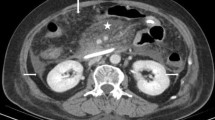Abstract
Background
The presence of necrotic collection in acute necrotizing pancreatitis (ANP) at intra-abdominal sites other than the retroperitoneum has not been systematically studied.
Aim
To investigate unusual sites of necrotic collections at computed tomography (CT) and to evaluate association with pancreatic necrosis and clinical outcomes.
Methods
This retrospective study comprised of consecutive patients with ANP evaluated between January 2018 and March 2019. Based on CT findings, patients were divided into two groups: collections at unusual sites (small bowel mesentery, mesocolon, omentum, subcapsular collections along liver and spleen, pelvis, anterior abdominal wall, and inguinoscrotal regions) and collections at usual retroperitoneal locations (lesser sac, gastrosplenic location, anterior and posterior pararenal spaces, and paracolic gutters). The differences in CT findings and clinical outcomes (need for drainage, length of hospitalization, intensive care unit admission, surgery, and death) between the two groups were evaluated.
Results
A total of 75 patients with ANP were evaluated. There were 25 (33.3%) patients with collections in unusual locations. These included mesentery (n = 17), splenic subcapsular location (n = 7), omentum (n = 6), hepatic subcapsular location (n = 4), anterior abdominal wall (n = 3), pelvis (n = 2), and inguinoscrotal location (n = 1). Compared to patients with collections at usual locations (n = 50), there were no differences in the CT findings except complete parenchymal necrosis (32% vs. 0%, P = .001). There were no statistically significant differences in the clinical outcomes between the two groups.
Conclusions
Mesenteric collections are frequent in ANP. The other non-retroperitoneal sites are infrequently involved. There is no association between unusual sites of collection and clinical outcomes.

Similar content being viewed by others
References
Dhaka N, Sinha SK, Samanta J, et al. Impact of the site of necrosis on outcome of acute pancreatitis. JGH Open. 2018;2:295–299.
Gupta P, Rana P, Bellam BL, et al. Site and size of extrapancreatic necrosis are associated with clinical outcomes in patients with acute necrotizing pancreatitis. Pancreatology. 2020;20:9–15.
Chi XX, Zhang XM, Chen TW, et al. The normal transverse mesocolon and involvement of the mesocolon in acute pancreatitis: an MRI study. PLoS ONE. 2014;9:e93687.
Jardosh Y, Bhagat H, Sharma R, Upadhya D. Pancreatic pseudocysts and their unusual locations. Natl J Med Res. 2016;6:251–256.
Kumar P, Gupta P, Rana S. Thoracic complications of pancreatitis. JGH Open. 2018;3:71–79.
Kalia S, Gupta R, Shenvi SD, et al. Inguinoscrotal region as an unusual site of extrapancreatic collections in infected pancreatic necrosis. Gastroenterol Rep (Oxf). 2016;4:246–250.
Lee AD, Abraham DT, Agarwal S, et al. The scrotum in pancreatitis-case report and review of literature. JOP. 2004;5:357–359.
Kim SB, Je BK, Lee SH, et al. Scrotal swelling caused by acute necrotizing pancreatitis: CT diagnosis. Abdom Imaging. 2011;36:218–221.
Branco JC, Cardoso MF, Lourenço LC, et al. A rare cause of abdominal pain in a patient with acute necrotizing pancreatitis. GE Port J Gastroenterol. 2018;25:253–257.
Kamble PM, Patil A, Jadhav S, Rao SA. Anterior abdominal wall abscess with epididymo-orchitis: an unusual presentation of acute pancreatitis. J Postgrad Med. 2011;57:335–337.
Mallick B, Dhaka N, Gupta P, et al. An audit of percutaneous drainage for acute necrotic collections and walled off necrosis in patients with acute pancreatitis. Pancreatology. 2018;18:727–733.
Ishikawa K, Idoguchi K, Tanaka H, et al. Classification of acute pancreatitis based on retroperitoneal extension: application of the concept of interfascial planes. Eur J Radiol. 2006;60:445–452.
De Waele JJ, Delrue L, Hoste EA, De Vos M, Duyck P, Colardyn FA. Extrapancreatic inflammation on abdominal computed tomography as an early predictor of disease severity in acute pancreatitis: evaluation of a new scoring system. Pancreas. 2007;34:185–190.
Mendez G Jr, Isikoff MB, Hill MC. CT of acute pancreatitis: interim assessment. AJR Am J Roentgenol. 1980;135:463–469.
Malka D, Hammel P, Lévy P, et al. Splenic complications in chronic pancreatitis: prevalence and risk factors in a medical-surgical series of 500 patients. Br J Surg. 1998;85:1645–1649.
Heider R, Behrns KE. Pancreatic pseudocysts complicated by splenic parenchymal involvement: results of operative and percutaneous management. Pancreas. 2001;23:20–25.
Mortele KJ, Mergo PJ, Taylor HM, Ernst MD, Ros PR. Splenic and perisplenic involvement in acute pancreatitis: determination of prevalence and morphologic helical CT features. J Comput Assist Tomogr. 2001;25:50–54.
Hastings OM, Jain KM, Khademi M, Lazaro EJ. Intrasplenic pancreatic pseudocyst complicating severe acute pancreatitis. Am J Gastroenterol. 1978;69:182–186.
Okuda K, Sugita S, Tsukada E, Sakuma Y, Ohkubo K. Pancreatic pseudocyst in the left hepatic lobe: a report of two cases. Hepatology. 1991;13:359–363.
Demeusy A, Hosseini M, Sill AM, Cunningham SC. Intrahepatic pancreatic pseudocyst: a review of the world literature. World J Hepatol. 2016;8:1576–1583.
Gupta P, Gupta J, Kumar C, et al. Aggressive percutaneous catheter drainage protocol for necrotic pancreatic collections. Dig Dis Sci. 2020. https://doi.org/10.1007/s10620-020-06116-6.
Gupta P, Koshi S, Samanta J, et al. Kissing catheter technique for percutaneous catheter drainage of necrotic pancreatic collections in acute pancreatitis. Exp Ther Med. 2020. https://doi.org/10.3892/etm.2020.8897.
Gupta P, Dawra S, Chandel K, et al. Fat-modified computed tomography severity index (CTSI) is a better predictor of severity and outcome in patients with acute pancreatitis compared with modified CTSI. Abdom Radiol (NY). 2020. https://doi.org/10.1007/s00261-020-02473-y.
Gupta P, Jain R, Koshi S, et al. Radiation dose from computed tomography in patients with acute pancreatitis: an audit from a tertiary care referral hospital. Abdom Radiol (NY). 2020;45:1517–1523.
Author information
Authors and Affiliations
Corresponding author
Ethics declarations
Conflict of interest
The authors declare that they have no conflict of interest.
Additional information
Publisher's Note
Springer Nature remains neutral with regard to jurisdictional claims in published maps and institutional affiliations.
Rights and permissions
About this article
Cite this article
Gupta, P., Virk, M., Gulati, A. et al. Unusual Sites of Necrotic Collections in Acute Necrotizing Pancreatitis: Association with Parenchymal Necrosis and Clinical Outcomes. Dig Dis Sci 66, 2362–2367 (2021). https://doi.org/10.1007/s10620-020-06526-6
Received:
Accepted:
Published:
Issue Date:
DOI: https://doi.org/10.1007/s10620-020-06526-6




